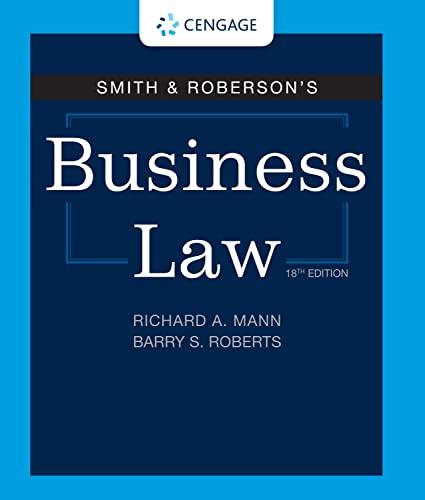Question
When dealing with multiple issues in a client's case, address each issue separately and completely before proceeding to the next issue. a. True b. False
When dealing with multiple issues in a client's case, address each issue separately and completely before proceeding to the next issue.
| a. | True | |
| b. | False |
2.The identification of the issue determines which direction the research will take.
| a. | True | |
| b. | False |
3.If the issue is misidentified, malpractice may result, because the client is billed for a service not requested.
| a. | True | |
| b. | False |
4.The facts component of an issue is composed of the key facts and sufficient background facts to identify the context of the dispute.
| a. | True | |
| b. | False |
5.A narrow statement of the issue fails to inform the researcher of the specific factual context of the dispute.
| a. | True | |
| b. | False |
6.The identification of the issue:
| a. | Is the first step of the legal analysis process | |
| b. | Is the most important task that a researcher faces when engaging in legal analysis | |
| c. | Determines the direction that the research will take | |
| d. | May result in malpractice if it is misidentified | |
| e. | All of the above | |
| f. | Answers a, b, and c above | |
| g. | Answers a and b above |
7.The issue in a client's case is composed of which of the following parts?
| a. | Sufficient background facts to identify the context of the dispute | |
| b. | Key facts | |
| c. | The legal question | |
| d. | The applicable law | |
| e. | All of the above | |
| f. | Answers b, c, and d above |
8.The identification of the issue(s) in a client's case requires the:
| a. | Identification of the general areas of law involved | |
| b. | Identification of the elements of the cause(s) of action | |
| c. | Identification of the key and background facts | |
| d. | Assembly of the issue | |
| e. | All of the above | |
| f. | Answers a, b, and d above | |
| g. | Answers b and d above |
9.In regard to the identification of the issue(s) in a court opinion:
| a. | When the case has more than one issue, follow the steps separately and completely for one issue before proceeding to identify the next issue | |
| b. | The issue may be stated more clearly in a concurring opinion | |
| c. | The issue may be stated more clearly in a dissenting opinion | |
| d. | Look to the holding | |
| e. | All of the above | |
| f. | Answers a, b, and d above |
10.Which of the following are broad statements of the issue?
| a. | "The issue in this case is whether the defendant breached the contract." | |
| b. | "The issue in this case is whether the trial court erred when it granted the motion to suppress the evidence." | |
| c. | "The issue in this case is whether it is false imprisonment when law enforcement officers make an arrest." | |
| d. | "The issue in this case is whether an individual commits battery by being at the scene of a battery." | |
| e. | All of the above. |
Respond to these questions:
1. How do you test to determine if your statement of the issue is complete?
2. Why do we want a comprehensive/narrow statement of the issue?
3. Why must the issue be stated objectively?
4. When drafting with multiple issues, why should they be separated?
5. Go tothis site https://www.alu.edu/alublog/master-legal-writing-with-the-irac-method/
to see our blog about IRAC. What advice to they give about the "I" in IRAC?
Step by Step Solution
There are 3 Steps involved in it
Step: 1

Get Instant Access to Expert-Tailored Solutions
See step-by-step solutions with expert insights and AI powered tools for academic success
Step: 2

Step: 3

Ace Your Homework with AI
Get the answers you need in no time with our AI-driven, step-by-step assistance
Get Started


